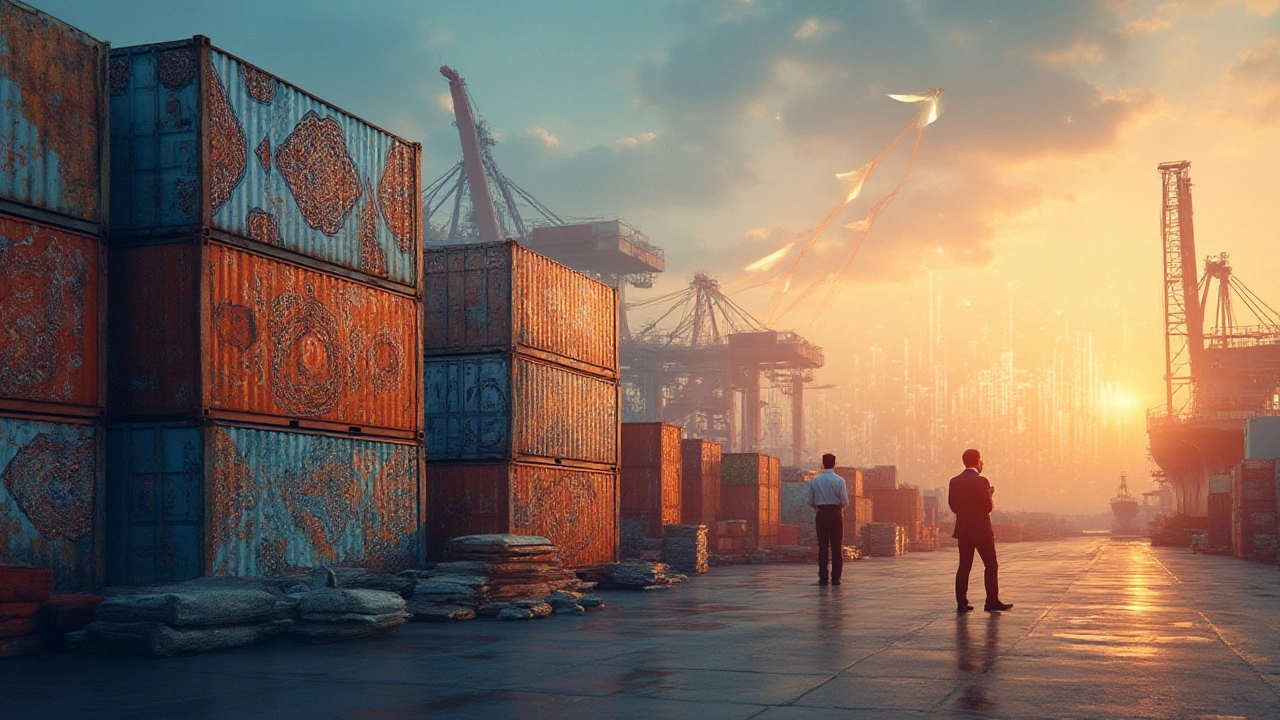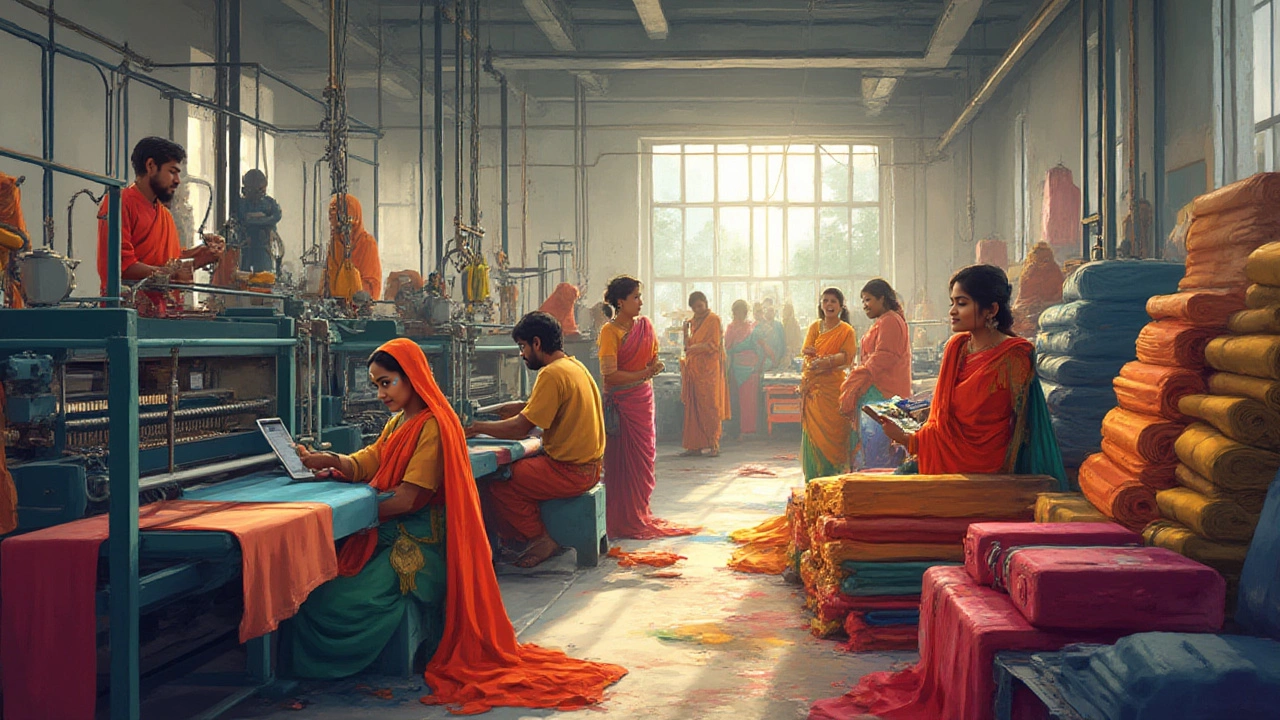Picture this—some of the most colorful clothes in your wardrobe might have started their journey in a crowded, humming textile mill in Surat or Coimbatore. When people talk about textiles, India is always somewhere in the mix. But where does it really stand on the global textile stage? The numbers might surprise you. Indian textiles aren't just about age-old traditions or intricate saris. We're talking global reach, billions of dollars, millions of jobs, and some spicy international competition.
India’s Real Rank in Global Textile Manufacturing
So where does India stand in the world of textile manufacturing? Let’s clear up the confusion. According to the Ministry of Textiles and global trade data for 2024, India is the second-largest textile manufacturing country in the world, just behind China. This isn't a recent trend. If textile competition was a cricket match, China would still be a few overs ahead, but India has kept up deliveries and bats with power.
Get this: India accounts for about 7% of global textile and apparel exports which is huge, considering the world market rolls at over $800 billion. In cotton textiles, India leads the pack. It's actually the single largest producer of cotton and jute globally. When it comes to synthetic fibers, things get trickier since countries like Vietnam and Bangladesh are picking up speed, but India still hangs tough in the top running.
Let’s talk numbers. India’s textile industry is worth more than $220 billion. Nearly half of this comes from exports, with the rest going to feed a hungry domestic market of 1.4 billion people who love their kurtas, jeans, scarves, and bed sheets. The industry gives jobs to about 45 million people directly and 60 million more in related sectors. So, when you’re wearing denim stitched in Ahmedabad or a shawl woven in Kashmir, you’re actually part of something massive.
Textiles have deep roots in India—it’s an industry older than most countries on the planet. Even if modern export numbers didn’t matter, historical pride definitely does. The old Silk Route? India was always in the thick of it. But let’s get real—rankings change because there’s tough competition. Countries like Bangladesh and Turkey are eating up a slice of the international pie. Still, in 2025, India stubbornly sticks to its spot as #2 for both textiles and apparels, just trailing behind China.
Think that’s impressive? Wait till you see which states run the show. Gujarat, Maharashtra, Tamil Nadu, and West Bengal have a fierce rugby scrum going on for top production honors. Surat alone claims to make almost 30 million meters of raw fabric per day. That’s enough cloth daily to stretch from Mumbai to Dubai—if you ever wanted to walk on Indian-made fabric across the Arabian Sea, well, it could happen!
Secrets Behind India’s Textile Powerhouse Status
How does India manage to keep churning out textiles on such a massive scale? The secret sauce isn’t just skilled labor or cheap yarn. There’s history, culture, and a little bit of government muscle that makes all the difference.
For starters, India isn’t new to the game. Textile traditions date back at least 5,000 years, right to the Indus Valley. Those block prints you see in trendy stores in London or New York? Some of the exact same patterns were carved and used in ancient Mohenjo-Daro. That’s the kind of heritage Indian manufacturers stand on. But it’s not all about nostalgia.
The other big reason is scale. Take cotton. India has the world’s largest area under cotton cultivation—about 12.4 million hectares, more than anywhere else. Think enormous farms, thousands of ginning factories, and a pipeline of trade networks that keep the raw material—and the money—flowing. The Punjab farmer’s cotton ends up as a school uniform in Nigeria or a tablecloth in New York. Pretty wild, right?
Now, let’s talk about government support. There’s been a deliberate push to make the whole value chain stronger. Policies like the Production Linked Incentive (PLI) Scheme launched in 2021, gave financial kick-starts to boost export-oriented textile manufacturing. There’s also the Technology Upgradation Fund Scheme (TUFS)—a mouthful, but it basically helps small factories modernize so they’re not just sweating it out with 1970s machinery.
The diversity in products is another edge. India does everything: raw fibers, spinning yarn, weaving, garment stitching, fancy embroidery, eco-dyeing, printing, and retail packaging. Here’s a crazy fact: India is the world’s largest producer of jute and a key global player in silk production, contributing about 17% of the world’s raw silk output. Try finding another country with that kind of range.
Of course, labor costs matter. With millions of skilled artisans, factory workers, and tailors working for wages that are still competitive compared to places like Turkey or Eastern Europe, India keeps the costs down and the output up.
Here’s a gem: the Digital India push is changing the game. Exporters can now connect directly with buyers worldwide, skipping outdated middlemen. Platforms like IndiaMart or even Instagram have become mini-marketplaces for Indian textile brands. All this, and we haven’t even touched on the fashion weeks, Bollywood influence, or the massive use of Indian textiles by global designers.
According to a 2024 McKinsey report, "India’s scale and diversity in textile manufacturing is nearly unmatched. From traditional handlooms to high-tech smart fabrics, the country packs tradition into modern technology."
“For every fabric innovation, there’s a factory somewhere in India willing to take up the challenge,” — Textile technologist Meena Bhandari, Textile India 2024 Conference.

How India Compares: China, Bangladesh, and the Rest of the World
Now, if you’re thinking about who the real competition is, China’s shadow looms large. China is the top dog in textile production—no surprise there. It leads thanks to mammoth investments in automation, massive domestic consumption, and export-friendly policies. Annually, China exports about $270 billion worth of textiles and apparel.
But here’s the twist. China is slowly moving up the value chain into high-tech fabrics and expensive designer goods. That leaves an opening, and countries like Bangladesh are rushing in. Bangladesh isn’t big on producing fibers, but it absolutely crushes it in finished garments. The country exported $47 billion in clothing and apparel in 2023, catching up to India at a frenetic pace.
Vietnam and Turkey are hungry, too. Vietnam focuses on efficiency, speed, and top-to-toe supply chains that make it a darling in the fast fashion world. Turkey, on the other hand, gets lots of love from the EU because of its proximity and special trade terms.
Where does this leave India? Still in the lead, after China. But the gap is closing, and everyone knows it. While India dominates the raw fiber and intermediate textile markets, the push is on to climb up the value ladder—think stylish ready-made garments, technical textiles for cars and airplanes, and eco-friendly fabrics.
So what’s holding India back from snagging the number one spot? There are some speed bumps. Fragmentation is one—most textile factories are small-scale, family-run operations that need more coordinated investment into technology and training. Logistics can be a pain, with slow ports and high transport costs compared to competitors. But the momentum is there, especially as Western brands rethink their China strategy and look for safer, reliable partners after COVID-19 supply chain chaos.
And here’s the kicker—India’s domestic market is exploding. With a rising middle class, people want quality, variety, and brands. International brands are investing in India to manufacture for both exports and domestic shelves. Local designers are making it big outside, and suddenly Indian fashion isn’t just for weddings, it’s runway-credible across the world.
Changing Trends and Tips for Riding the Textile Wave
The textile world doesn’t stand still for anyone. What made India strong yesterday might not cut it tomorrow. That’s why the industry is feverishly adapting, and why knowing these trends can set you up for success if you’re part of this world—factory owner, investor, or even a student thinking textiles.
Eco-textiles are all the rage. Consumers everywhere are asking for sustainable, organic, climate-conscious fabrics. Companies like Arvind and Welspun have pounced on this demand, rolling out lines made with zero water wastage, recycled fibers, and non-toxic dyes. India’s natural affinity for organic cotton and traditional handlooms is now its big selling point abroad. If you’re starting up, this is your chance to stand out!
Digital transformation is not up for debate. Factories that adopt automation, IoT-based sensors, and digital sales platforms see faster orders, fewer mistakes, and better margins. Even a simple thing like a QR code that traces a garment’s journey—field to shelf—makes a difference. Don’t stick to luddite habits if you want to survive.
The shift toward technical textiles is also a game-changer. These are fabrics with a job: fire-resistance for firefighters, lightweight strength for cars and airplanes, or super-absorbent hospital sheets. The Indian government has earmarked about $1.5 billion for this emerging sector, knowing it’s where the biggest growth lies.
Tips for newcomers? Don’t ignore design. While mass-produced basics work, unique prints, regional crafts, and edgy collaborations can help you climb higher. Make smart use of digital marketing. More export opportunities open up if you learn about compliance—like Europe’s tight safety rules or America’s traceability demands. Network with industry groups, and pay attention to new free-trade agreements. India is now part of deals with countries like Australia and the UAE—lower taxes, faster shipping, less red tape.
One last point: keep a sharp eye on quality. Cheap labor isn’t enough these days. International brands can cut you loose over a single missed shipment or a social media scandal about working conditions. Invest in people: skill training, better safety gear, and good work environments. Happy, skilled teams churn out better products, and happy buyers come back for more.
To wrap up, that "Made in India" label on your next piece of clothing is more than just a tag—it’s a story of world-class manufacturing, resilience, and a race that’s far from over. If you want to know where India stands, it’s right up there—second in the world, with hungry competition at its heels, and serious plans for the top spot.
